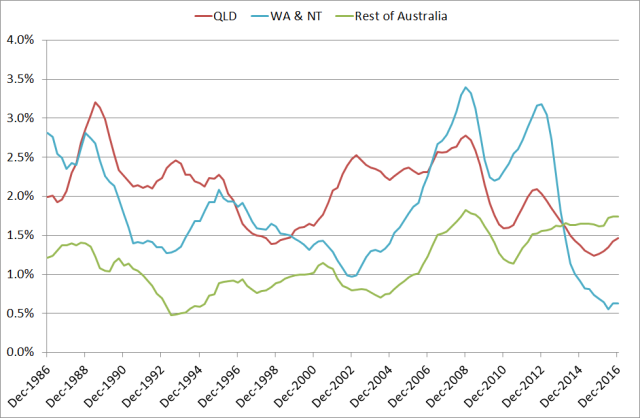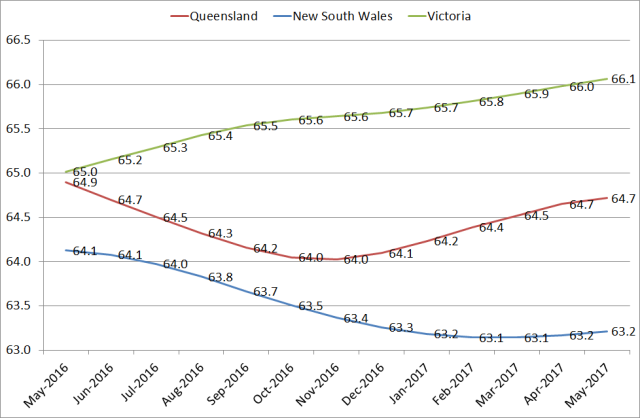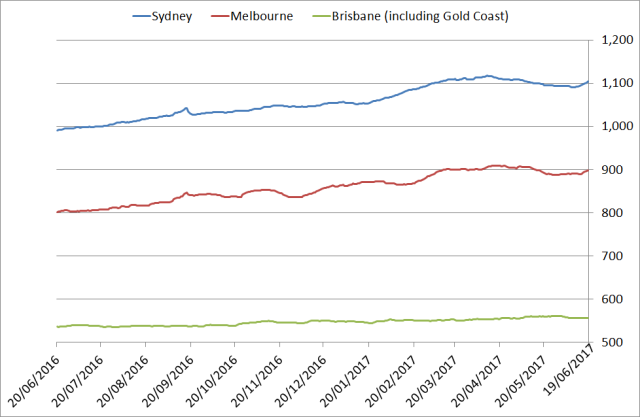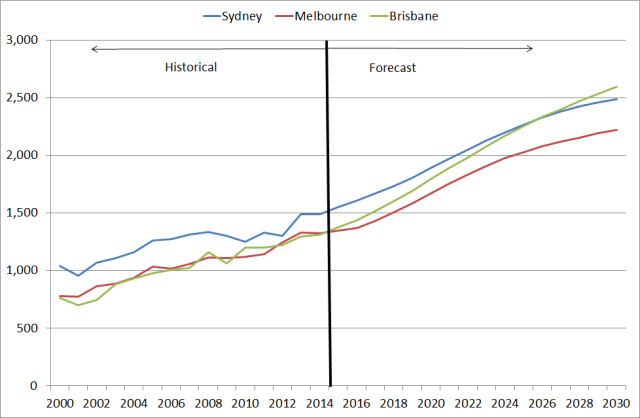I am delighted to publish a guest post from my friend and fellow economist Dr Alistair Robson on the slowdown in Queensland’s population growth in recent years. GT
Population Growth – Queensland’s recent slump
By Dr Alistair Robson
Queensland has traditionally had a relatively high population growth rate compared with the rest of Australia, with the exception of Western Australia and the Northern Territory. But recently this has not been the case. As shown in the recent Queensland Budget papers, Queensland’s population growth has been historically low recently. The Figure below shows the current population growth rate in historical perspective.
Figure 1: Population Growth by Region of Australia

Source: ABS, 3101.0
The annual growth rate is near the lowest point in at least three decades. This is significant for Queensland which has long held a position as a high population growth state of Australia. The decline was led mainly by lower annual growth in Net Overseas Migration and Net Interstate Migration—see Figure 2.
Figure 2: Contributors to change in Population, Year to Dec. Quarter 2016 vs. a decade earlier

Source: Author, based on ABS cat. No. 3101.0
As seen in the above figure Net Overseas Migration has fallen by 13,230 people in the year to the December Quarter 2016 compared with a decade earlier. Much of this fall is likely due to fewer foreign workers living and working in mining communities. Net Interstate Migration was also much lower than a decade ago. This was also likely to due to the mining downturn.
The booming New South Wales economy has meant net arrivals from New South Wales have fallen significantly to 9,360 in the year to the December Quarter 2016 from 17,340 a decade before. More people moved to Victoria in net terms in the year to the December Quarter 2016 compared with more people moving from Victoria to Queensland a decade ago—see Figure 3.
Figure 3: Net Arrivals to Queensland, Year to Dec. Quarter 2016 vs. a decade earlier

Source: Author, based on ABS cat. No. 3101.0
New South Wales still remains the dominant source state for net interstate migration into Queensland, but Victoria has now be replaced by Tasmania in second place and South Australia in third place. Indeed, Victoria is now the only state to receive more people from Queensland than the other way around.
Economic conditions typically influence interstate moves. Looking at some of the key employment drivers we can see Queensland employment growth has been picking up recently, as it has in New South Wales. Victorian employment growth remains well higher than both New South Wales and Queensland—see Figure 4.
Figure 4: Employment Growth over the year, Trend

Source: ABS, cat. No.: 6202.0
Unemployment rates in New South Wales remain well below those in Queensland. Still, the paths of unemployment rates in New South Wales and Queensland over the past year have generally been similar. Curiously Victoria’s unemployment rate has been rising with the solid employment growth shown in the earlier graph—see Figure 5.
Figure 5: Unemployment rates, Trend

Source: ABS, cat. No.: 6202.0
This rising Victorian unemployment rate is partly due to increases in participation rates. An increasing participation rate is shared with Queensland, but New South Wales’s participation rate is curiously low—see Figure 6.
Figure 6: Participation Rates, Trend

Source: ABS, cat. No.: 6202.0
Victoria’s participation rates have been steadily rising over time compared with steadily falling New South Wales participation rates. This may be due to younger people moving to Victoria due to high house prices in Sydney. Younger people tend to have a higher participation rate than older age cohorts.
Looking forward, the mining downturn which hit regional Queensland hard seems to be at or near over (see Minutes of the Monetary Policy Meeting of the Reserve Bank Board on 6 June). Also the large infrastructure spending in the recent Queensland budget and lower exchange rate should boost the Queensland economy. These effects ought to reduce the number of people moving from Queensland to down south. Some people may even be attracted to move from the booming New South Wales and Victorian economies to Queensland.
Higher house prices in Sydney and Melbourne may see some people unable to move to those larger cities or people in Sydney and Melbourne selling their house, realising the additional equity, and buying a cheaper house in Brisbane—see Figure 7.
Figure 7: Home Price Index (Corelogic) – $’000

Source: Corelogic, CoreLogic Daily Home Value Index, https://www.corelogic.com.au/research/back-series.html
The most recent ABS Residential Property Price data show residential property prices for Sydney and Melbourne growing faster than for Brisbane—see Figure 8. These higher, and accelerating, residential property prices in Sydney and Melbourne ought to increase the attractiveness of Brisbane from a value for money perspective.
Figure 8: Residential Property Price Indexes

Source: ABS, cat. No.: 6416.0
Mitigating this effect to some degree will be the increasing, and eventually larger, congestion costs (delay costs) in Brisbane than Sydney and Melbourne on a per capita basis see Figure 9.
Figure 9: Trip Delay Costs, per capita ($2010)

Source: Department of Infrastructure and Regional Development (2015) Traffic and congestion cost trends for Australian capital cities, VKT and Summary Cost Data, Total Delay Cost (Upper Baseline scenario)
Sydney will remain the city with the highest delay costs per capita until 2026 when Brisbane is projected to overtake it. This is a “Business as Usual” scenario. Infrastructure projects such as Cross River Rail and the M1 and M2 upgrades ought to help reduce the chance of this eventuating.
From an employment perspective, if Brisbane can generate high paying corporate jobs, then more people should migrate from the larger and more crowded cities of Sydney and Melbourne to Brisbane.
Dr Alistair Robson is an Economist at Transport for New South Wales (TfNSW). He has a PhD in Economics from the University of Queensland. His views do not reflect those of TfNSW.

Nice work Alistair. Great analysis.
Lower house prices are a necessary but not sufficient condition for interstate migration I reckon. Jobs first. Post-boom in Queensland I am less optimistic on the population growth side of things.
Post-boom national low interest rates have provided us with all the trappings of a higher growth economy in Queensland – excess apartment construction, excess office construction and perhaps new levels of infrastructure investment too eventually as you suggest?
Problem is, many may start to wonder where the real economy has gone in the dark of this artificially stimulated construction activity – giving us empty apartments owned by people overseas, empty offices, empty shopfronts. A Potemkin nightmare?
Unless we can create a permanent ‘Post-growth’ economy via these measures it is hard be too positive. From which quarter do we to see a ‘real’ bounce back. What would happen if the US forces our interest rates back up?
Most likely it is a welcome to Japan of the last 20 years but with balance sheet recessions all around for Corporate, Consumer and Government! Ouch, if only we were not a centrally planned economy we might have been allowed to suffer a little and bounced back by now. Led by the rising animal spirits of free enterprise able to evolve and adapt to change.
Hi A to Z. Thank you for your observations. You raise a number of interesting points. Economies always follow a boom – bust cycle. Each cycle has its own features and time-frames. And the economy is constantly evolving as new technology and ways of producing is introduced. Fundamentally though the Queensland economy is strong and becoming stronger as the effects of the Mining bust ease off. I suspect Queensland economic and population growth will accelerate bar any unforeseen event.